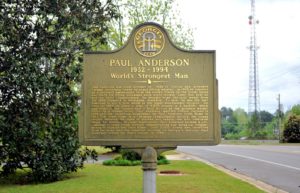This week’s #MarkerMonday highlights the life and legacy of professional strongman Paul Anderson. Born in Toccoa, Georgia, Anderson overcame Bright’s disease, a chronic inflammation of the kidneys, as a child. He attended Furman University on a football scholarship but resigned during the first year to focus on weightlifting. In 1955, he traveled as a goodwill ambassador to the Soviet Union, and during a weightlifting competition . Anderson quickly became a Cold War symbol of America’s strength and superiority. He went on to win the World Weightlifting Championships in 1955 and a gold medal in weightlifting in the super-heavyweight class from the 1956 Melbourne Olympic Games. Anderson returned home and pursued a career as a professional strongman. In 1961, Anderson and his wife, Glenda, established The Paul Anderson Youth Home, a Christian rehabilitation facility located in Vidalia, Georgia for young people ages 16-21. In 1974, Anderson was inducted into the Georgia Sports Hall of Fame. Dubbed the “Strongest Man of the Century” by the USA Power and Strength Symposium in 1992, Anderson died of kidney disease on August 15, 1994.
Explore the links below to learn more about Paul Anderson.
GHS is proud to house the Paul Anderson Papers, 1955-1992.
Full Marker Text
New Georgia Encyclopedia
Today in Georgia History

